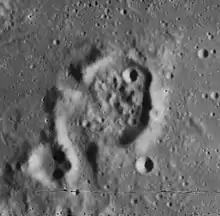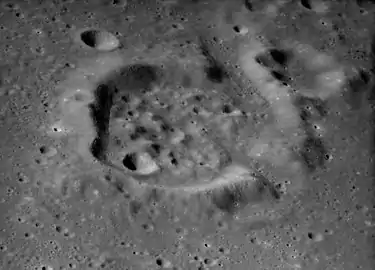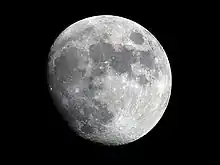Burnham (crater)
Burnham is a small crater located to the southeast of the crater Albategnius, in a relatively smooth area of the lunar surface. It was named after American astronomer Sherburne W. Burnham.[1] To the southwest is Vogel.
 Lunar Orbiter 4 image | |
| Coordinates | 13.9°S 7.3°E |
|---|---|
| Diameter | 25 km |
| Depth | 0.9 km |
| Colongitude | 353° at sunrise |
| Eponym | Sherburne W. Burnham |
The irregular tooth-like shape of the rim of Burnham protrudes to the southwest, giving the wall a distorted, asymmetric appearance. There are breaks in the rim to the northwest and southwest, the later forming a valley running about 15 km. The interior floor is rough and irregular, and lacks anything resembling a central peak. The abundance of small hills covering the crater floor from rim to rim makes it unusual.
Views
Satellite craters
By convention these features are identified on lunar maps by placing the letter on the side of the crater midpoint that is closest to Burnham.
| Burnham | Latitude | Longitude | Diameter |
|---|---|---|---|
| A | 14.8° S | 7.1° E | 7 km |
| B | 15.3° S | 7.3° E | 4 km |
| F | 14.3° S | 6.9° E | 9 km |
| K | 13.6° S | 7.4° E | 3 km |
| L | 14.2° S | 7.6° E | 4 km |
| M | 14.1° S | 9.0° E | 9 km |
| T | 14.7° S | 9.6° E | 4 km |
References
- "Burnham (crater)". Gazetteer of Planetary Nomenclature. USGS Astrogeology Research Program.
- Andersson, L. E.; Whitaker, E. A. (1982). NASA Catalogue of Lunar Nomenclature. NASA RP-1097.
- Bussey, B.; Spudis, P. (2004). The Clementine Atlas of the Moon. New York: Cambridge University Press. ISBN 978-0-521-81528-4.
- Cocks, Elijah E.; Cocks, Josiah C. (1995). Who's Who on the Moon: A Biographical Dictionary of Lunar Nomenclature. Tudor Publishers. ISBN 978-0-936389-27-1.
- McDowell, Jonathan (July 15, 2007). "Lunar Nomenclature". Jonathan's Space Report. Retrieved 2007-10-24.
- Menzel, D. H.; Minnaert, M.; Levin, B.; Dollfus, A.; Bell, B. (1971). "Report on Lunar Nomenclature by the Working Group of Commission 17 of the IAU". Space Science Reviews. 12 (2): 136–186. Bibcode:1971SSRv...12..136M. doi:10.1007/BF00171763.
- Moore, Patrick (2001). On the Moon. Sterling Publishing Co. ISBN 978-0-304-35469-6.
- Price, Fred W. (1988). The Moon Observer's Handbook. Cambridge University Press. ISBN 978-0-521-33500-3.
- Rükl, Antonín (1990). Atlas of the Moon. Kalmbach Books. ISBN 978-0-913135-17-4.
- Webb, Rev. T. W. (1962). Celestial Objects for Common Telescopes (6th revised ed.). Dover. ISBN 978-0-486-20917-3.
- Whitaker, Ewen A. (1999). Mapping and Naming the Moon. Cambridge University Press. ISBN 978-0-521-62248-6.
- Wlasuk, Peter T. (2000). Observing the Moon. Springer. ISBN 978-1-85233-193-1.
External links
| Wikimedia Commons has media related to Burnham (crater). |
- Burnham at The Moon Wiki
- Wood, Chuck (November 8, 2009). "Somewhere Over the Rainbow". Lunar Photo of the Day.
- Wood, Chuck (August 7, 2011). "Potpourri". Lunar Photo of the Day.
- Wood, Chuck (June 18, 2012). "Another Off the Beaten Track Place". Lunar Photo of the Day.
- Wood, Chuck (November 16, 2014). "An Image To End All Images (Almost)". Lunar Photo of the Day.



